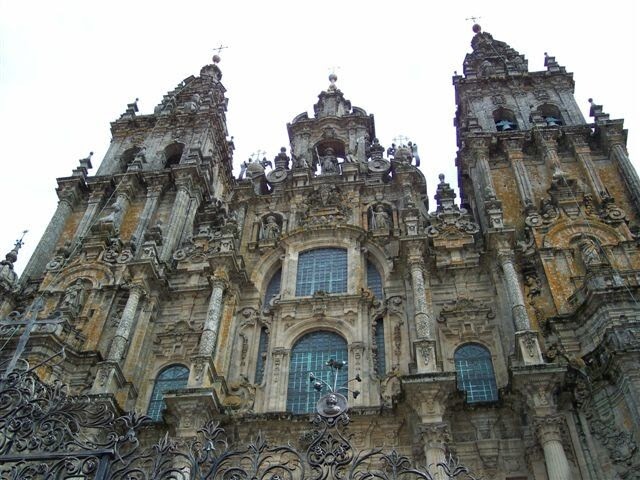
The Camino de Santiago is not a singular route. A vast artery of treks splay across Europe, like the branches of an oak tree. They all eventually converge and reach Santiago de Compostela. Each course combines gravel paths, wooded tracks, single-wide rural roads, cobblestone streets, and paved thoroughfares.
Though, the Camino de Santiago does have seven institutionalised thru-hikes. Each well-set route delivers substantial infrastructure for pilgrims. Walkers can take advantage of the restaurants’
menú del Peregrino (Pilgrim’s Menu), route markers, stamp bestowers, and
albergues (pilgrim hostels), which support a trekker’s journey.
As you brainstorm your Camino de Santiago trip, here are the most popular routes:
Camino del Norte
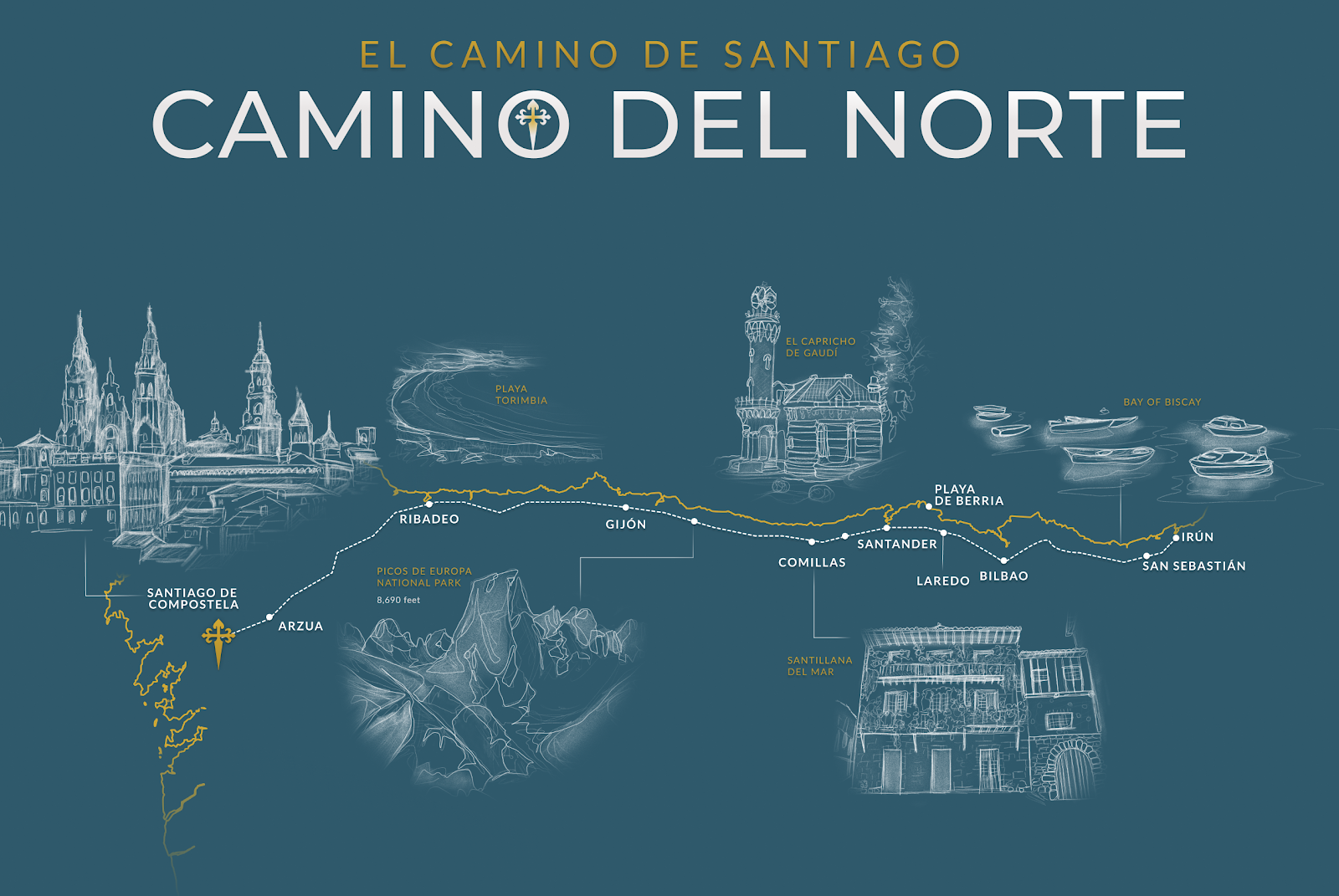
This 513-mile path is the northernmost route.
Camino del Norte threads a lush area known as Green Spain, which parallels the Atlantic Ocean. This section skirts through the regions of Basque Country, Cantabria, Asturias, and Galicia. The route starts in Irún, a city on the French border, and meanders up and down along the coastline.
From Laredo, hikers can opt for an inland variation through Colindres or stroll across the beach and hop on a ferry to Santoña. Back on land, walkers can mosey across the sandy crescent of Playa de Trengandin, a 3.7-mile idyllic gold beach. The shore and whitewater is speckled with clumps of course black volcanic rock. Pilgrims can close their day in Güemes.
Two stages later, pilgrims can visit the
Cave of Altamira, outside of Santillana del Mar. The UNESCO World Heritage site spotlights a 886-foot long Palaeolithic cavern with paintings and engravings. Next, walkers can soak up a sunset in Comillas. The seaside town is home to
El capricho de Gaudí, an oriental-inspired building with decorative sunflower tiles and a Persian minaret.
Halfway through the trek, the southern horizon fills with striking, towering limestone peaks: The
Picos de Europa, which have a silhouette of cheetah teeth. The range is surrounded by oak and beech groves in Picos de Europa National Park. The highest point is
Torre de Cerredo, which is 8,690 feet above sea level. But the N
aranjo de Bulnes—a 8,264-foot tower with a broad, flattish top—is the most iconic formation for travellers and mountaineers.
As hikers venture from Colombres to the port town of Llanes, the Peña Tú Monument arrives. The archeological site boasts pictographs, petroglyphs and burial mounds from the Neolithic Age. Past Llanes,
Playa Torimbia is a dreamy scallop-shell shaped beach that visitors can relish.
Salt-kissed air refreshes hikers as they explore quaint oceanside villages before curving inland to Santiago de Compostela. Fewer amenities and pilgrims are to be met along this way. Meaning, the route is a good fit for experienced trekkers. Reserve 30-35 days to cover this undulating terrain.
Camino Portugués
Also known as the
Portuguese Way, this northbound route is the flattest—therefore, easiest—choice and the sole departure from
Portugal. In entirety, this stretch is 383 miles and requires 25-27 days if hikers commence in Lisbon. From Porto, a variation exists along the coast.
Camino Primitivo
The 200-mile
Original Route rollercoasters due west through the Cantabrian mountains and northern Asturias region. The journey includes the
Catedral de San Salvador de Oviedo, in Oviedo, and offers seclusion with few crowds yet adequate accommodations. Hikers experience rigorous ascents and descents and a fair amount of dirt and grass tracks.
Plus, they can be immersed in nature during several longer days that are 16-19 miles. All considering, the Camino Primitivo is ideal for seasoned hikers. Set aside 12-15 days for this hike, which is the most ancient of the Camino de Santiago.
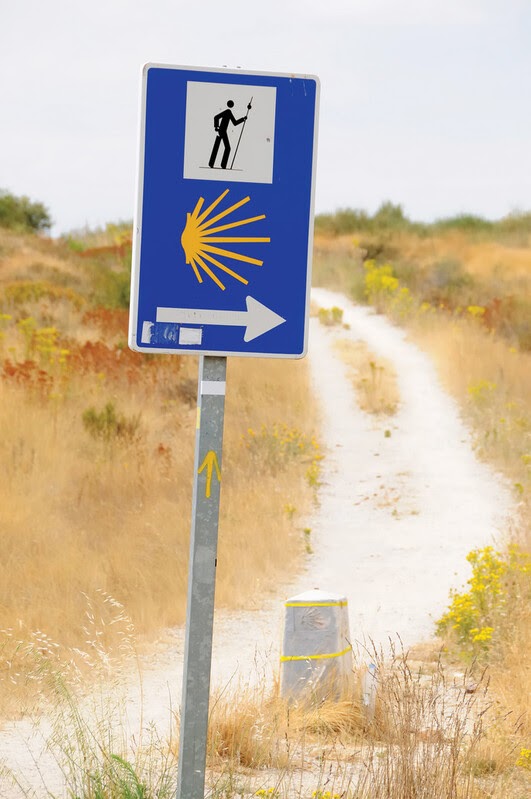
Camino Inglés
The English Way launches from the port city of Ferrol and is the shortest traditional itinerary at 75 miles. (A second option leaves from A Coruña but is not long enough to earn your Compostela.) Not many distance-walkers choose this Camino, so you’re bound to have more solitude. Walkers cover this distance in six days.
Vía de la Plata
Boasting a total of 621 miles, the Silver Way is the most extensive distance of the Camino itineraries. This southernmost passage starts in Seville, and links up historic cities, art, and architecture. The stages—meaning, the suggested segment that pilgrims should cover each day—are longer, so it’s not usually an attractive choice for first-timers. It’s also the least-walked route of all. Reserve at least 40 days to check-off these miles.
Camino Finisterre-Muxía
This leg is garnish for all of the Camino routes. Many travelers extend their walk from Santiago de Compostela westward to the seaside town Finisterre—which means end of the earth— against the Atlantic coast. The 71-mile iteration takes pilgrims north to the fishing village of Muxía then veers south to Finisterre and takes 3-5 days. At your endpoint, you can stroll 2 miles from town to the tip of the peninsula. There, the 1853 Faro de Fisterra (faro means lighthouse) stands over the rocky shore known as Costa de la Muerte, coast of death. If you go, be sure to take a portrait with the Camino mile-marker zero.
Camino Francés (the French Way/French Route)
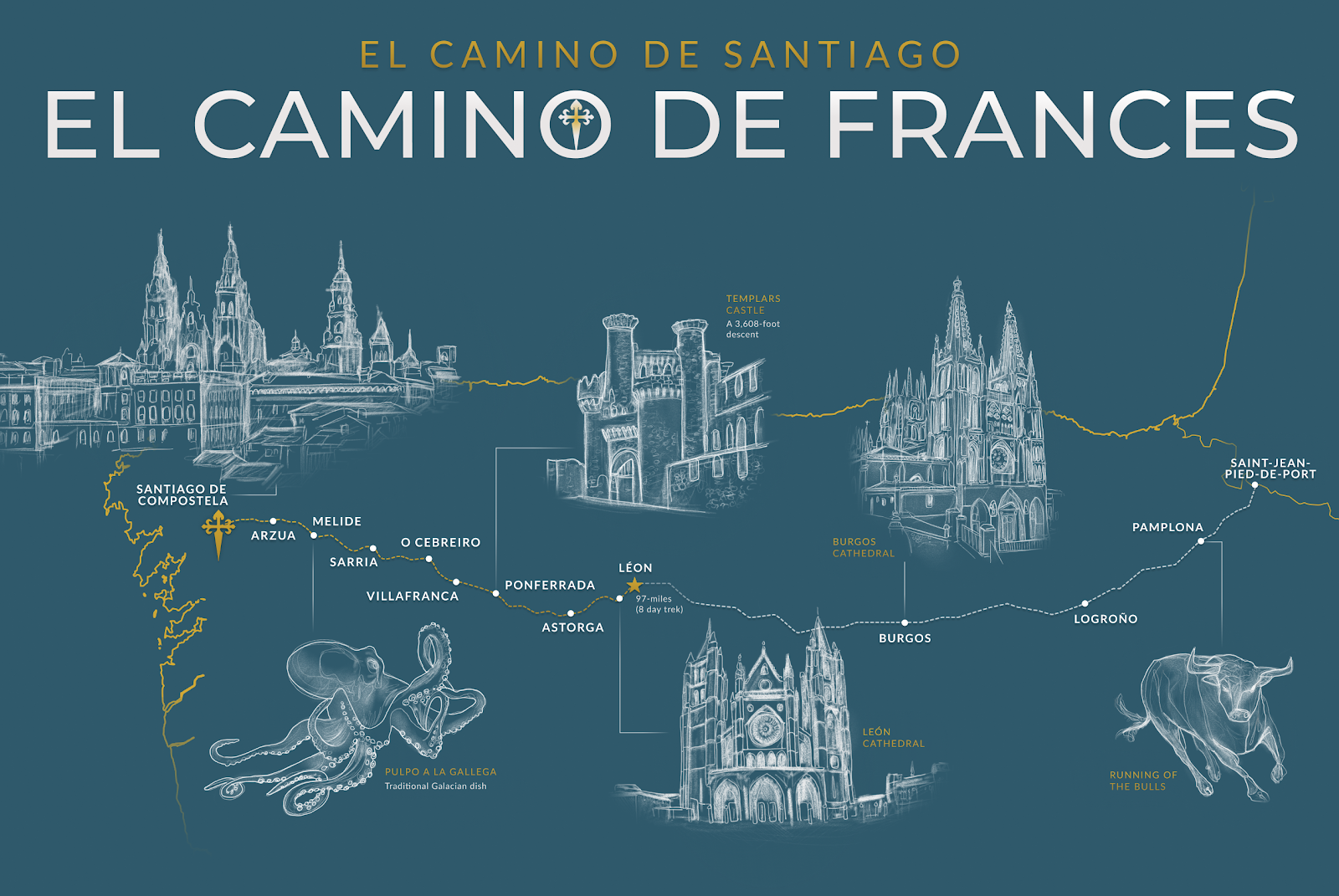
Hundreds of thousands of pilgrims pursue the Camino Francés each year, making this 491-mile path the most popular and accomplished in the entire history of the Camino. The flow of walkers is consistent year-round, and solo travelers seamlessly pair up with new friends and hiking partners.
“You’re not just experiencing Spain. You’re experiencing and learning about all kinds of cultures on the Camino Francés, because you meet and walk with so many people from Europe everyday, it’s unbelievable. The trail is a melting pot,” says Sherry.
Plentiful accommodations and historic sites make this route supportive for pilgrims as they cross the northern, inland
regions of Spain. Reserve at least 28 days for this trek if you wish to walk its entirety.
Saint-Jean-Pied-de-Port to Pamplona
The
French Way starts in Saint-Jean-Pied-de-Port, France, with a challenging 4,600-foot ascent through the Pyrenees mountains. The range stretches 270 miles between France and Spain with a 11,169-foot high point: Aneto Peak. The Pyrenees is also the location of the autonomous region Andorra. Hikers are surrounded by steep, emerald hillsides dotted with mountain pines. It’s a good idea to grab a (pre-booked) bed in Roncesvalles, on the Spanish side.
Hikers brace themselves for a lofty, rocky section above Zuzubiri, before the trail levels out in the Basin of Pamplona. Here, they reach the inaugural major city: Pamplona, the stomping ground of the famous San Fermin (The Running of the Bulls) festival. Pilgrims can stroll through the narrow streets past towering pastel buildings with elegant metal terraces. The medieval walls are chock-full of restaurants serving Basque country cuisine including
pintxos (tapas) bars, steaming bowls of marmitako, and coal-grilled cod.
Pamplona to Logroño
The next stage delivers crimson poppies, wheat and sunflower fields, and
El Alto del Perdón. The iconic metal sculpture shows 12 multi-century pilgrims on horseback and on foot. Later, 1.5 miles southwest of Estella, you’ll pass a wine fountain, a complimentary nectar to support pilgrims. The fountain is constructed in the stone wall of the 130-year-old Bodegas Irache winery. (A second tap provides water.)
Beyond the vineyards, olive trees, and cobblestone streets of Viana, the next major city is Logroño. The large town has a bustling vibe. Visitors can catch a bird’s-eye view from the bell tower of the Church of San Bartolomé. Be sure to stop beneath the jaw-dropping towers of
Catedral de Santa María de la Redonda, where you can see a small painting completed by Michelangelo.
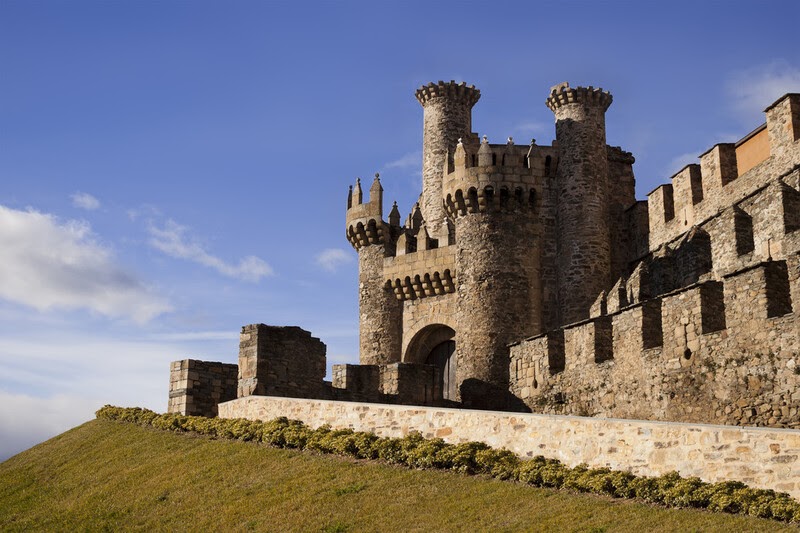
Logroño to Ponferrada
You’ll pass a sun-relieving pine forest before reaching Agés and the acclaimed city of Burgos. There, you can visit another architectural gem: the Gothic cathedral of Burgos with elaborate soaring spires above the city. For the next two weeks, the Meseta plains stretch into the horizon. Some pilgrims have a distaste for the Meseta’s monotonous topography while others love the wide open space.
“The Meseta is known as a boring, flat section that gets a really bad rap. The distances between villages are much longer, so the days tend to be harder in that sense. There are not many trees. But, I grew up in the Midwest, and the Meseta struck me. I developed a love for it. It was meditative from the sounds and smells to watching farmers in the fields,” says Sherry.
Next, the historic city of León is a top choice for many travellers to start their Camino, with a 13-day, 188-mile walk to reach Santiago de Compostela. Travellers, especially those with tighter schedules, can also join Explore Worldwide on an
8-day, 97-mile walk to reach Santiago de Compostela from León. The tour includes vehicle support and the top highlights on this segment of the El Camino walk. At this point, walkers can experience a taste of the Meseta before reaching Astorga, the grounds of the imposing storybook Palace of Gaudí. There, the Meseta fades into a landscape that’s more uneven, forested, and receives more rain.
After passing through Foncebadón, you’ll reach
Monte Irago--one of the highest points of the entire Camino de Santiago--which is marked with an iron cross. Then, take your time on the rock-strewn, arduous 3,608-foot descent into Ponferrada. The city possesses the Templars Castle, which was built for pilgrims in 1,178 AD. Today, travellers can tour the castle adjacent to the Sil River.
Ponferrada to Santiago de Compostela
The next leg delivers one of the tougher days on the Way. Hikers embrace a 2,300-foot uphill to O Cebreiro, where they’re rewarded with a vista of layered ridgelines as they reach the tiny, wind-battered settlement set high above a patchwork of green valleys. The village is famed for its traditional architecture, called
pallozas: circular, thatch-roofed, stone-walled homes, which still stand. Many pilgrims, like Brittany and Frank, opt for a 5-day trek that starts in Sarria, which is four stages after Ponferrada.
“The most popular version of the Camino is Camino Francés, and we did the short version. My dad is retired and he started before us with the rest of our group. Frank and I aren’t retired and didn’t have as much time to spend on the Camino,” says Brittany. The 72-mile journey from Sarria to Santiago de Compostela also fulfills the requisite distance to earn a Compostela. (The next town over is Portomarin, which is only 58 miles from the end of the Camino.)
The route winds through chestnut trees, farm fields, and delivers pilgrims to Melide, where
pulpo (octopus) is a staple. Try the warm, traditional Galician dish
pulpo a la gallega: the pulpo is cooked in a copper cauldron and mixed with smoked paprika and potatoes. The passage continues through villages, thick groves, and oscillating terrain. Lastly, reflect on your journey in Praza do Obradoiro, the main square of Santiago de Compostela, on the west side of the Santiago de Compostela cathedral.
